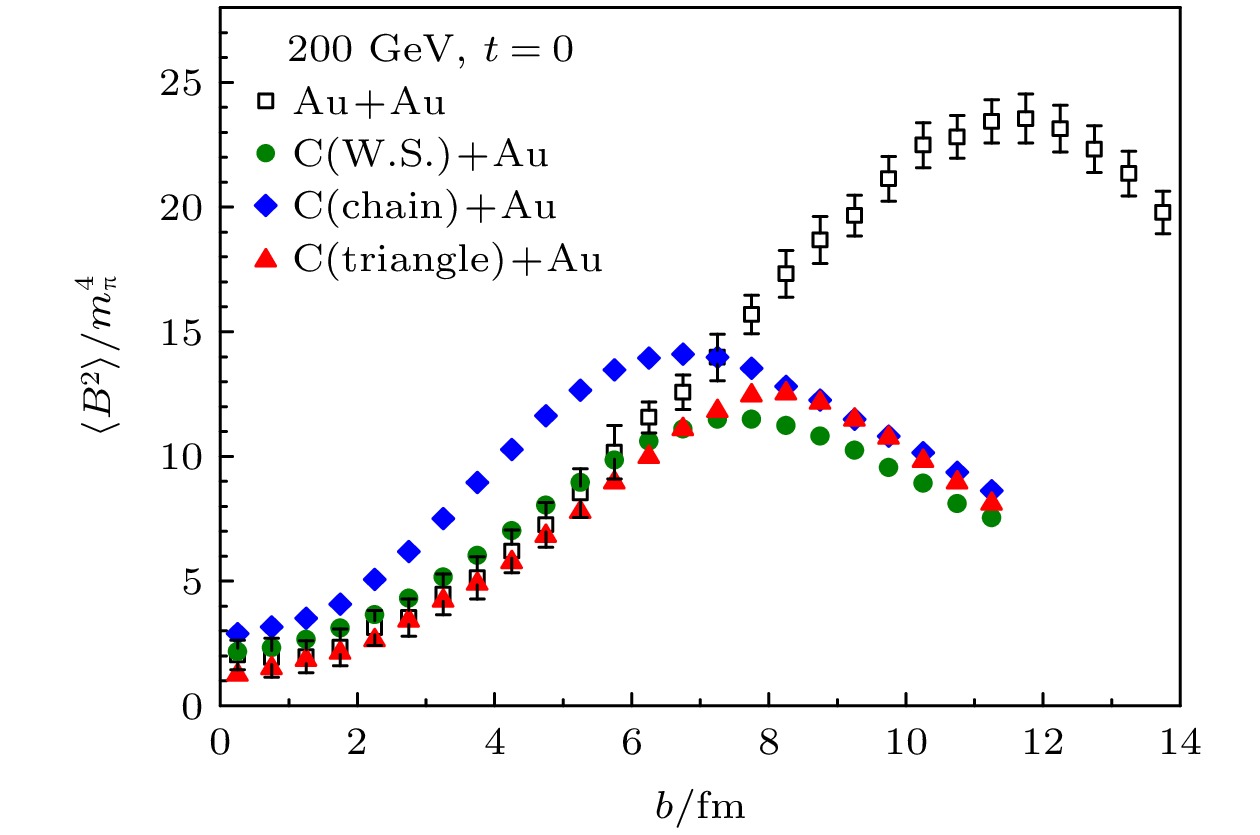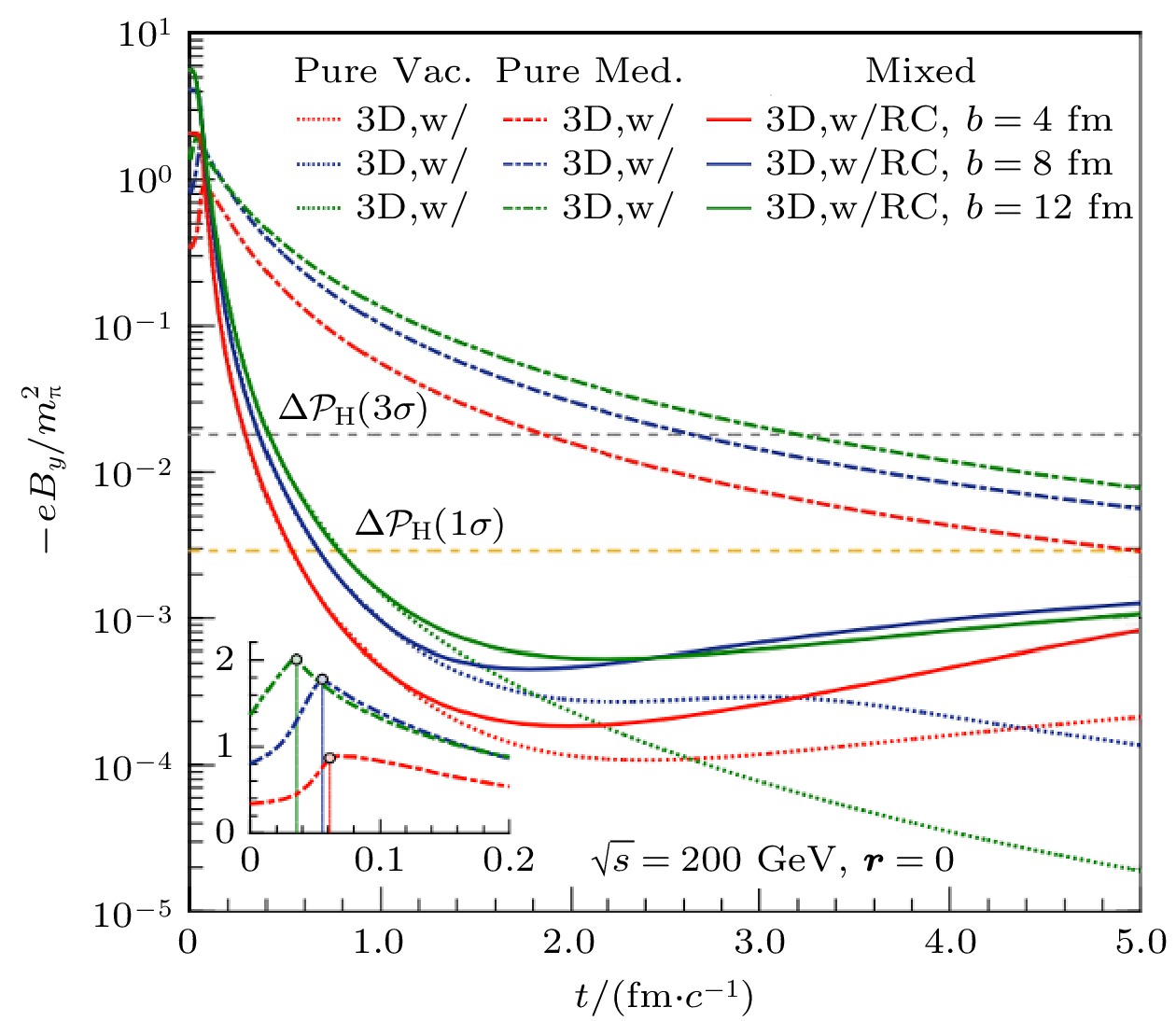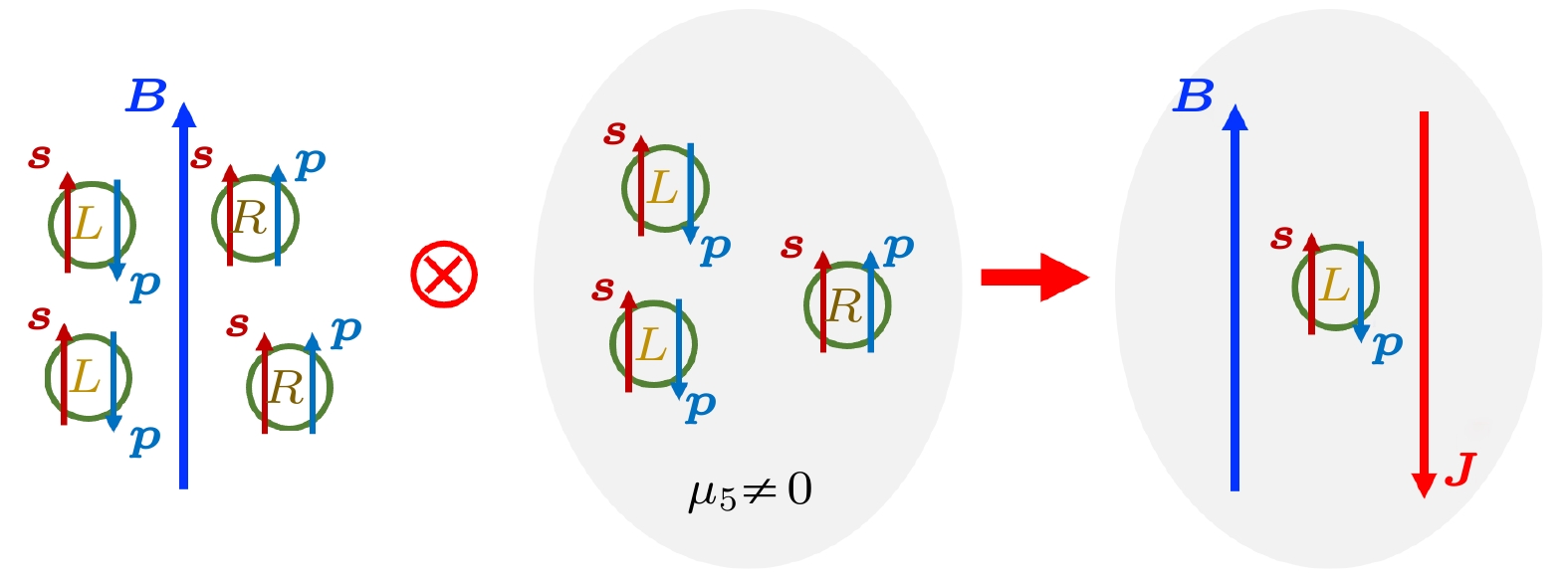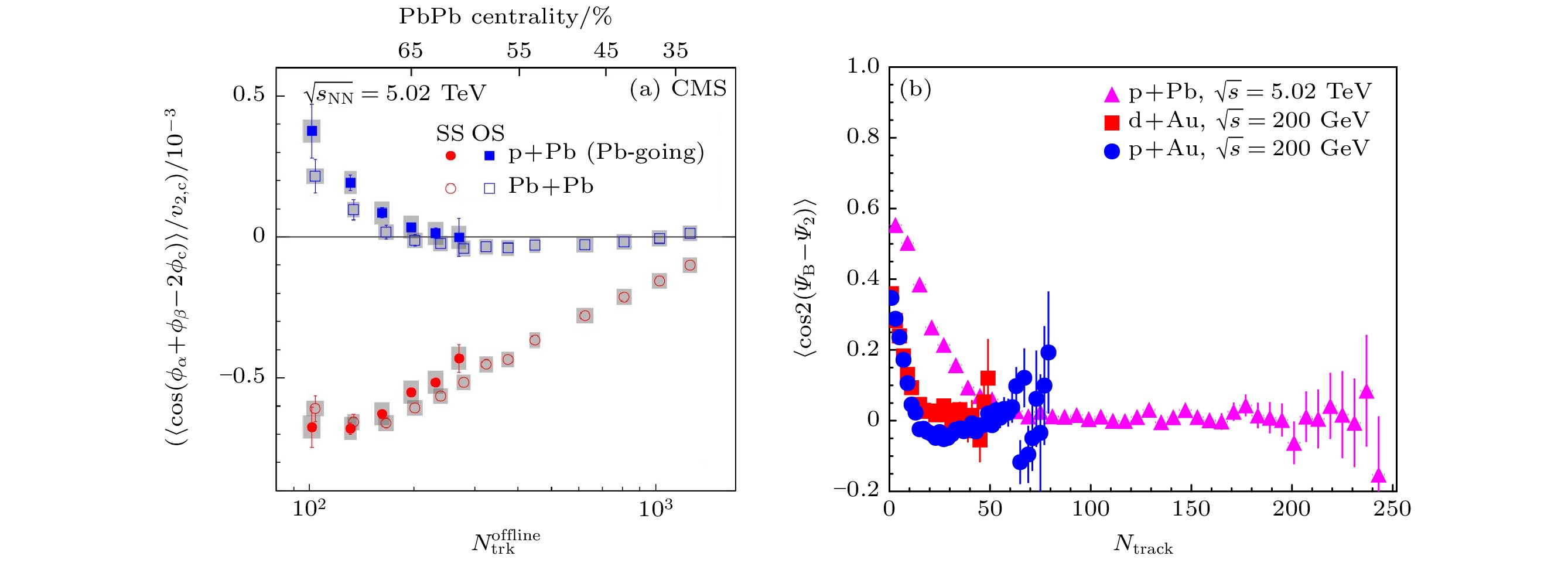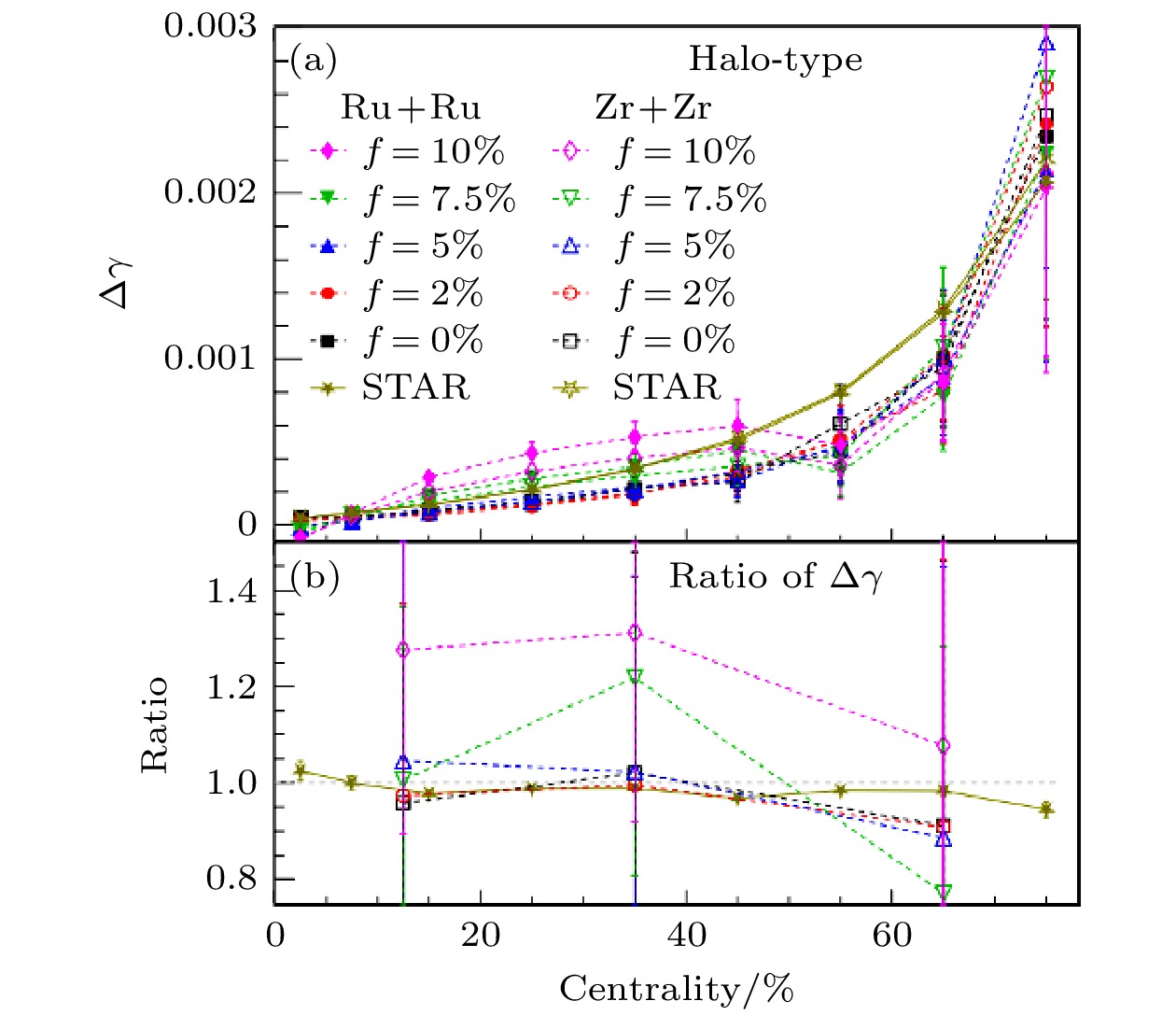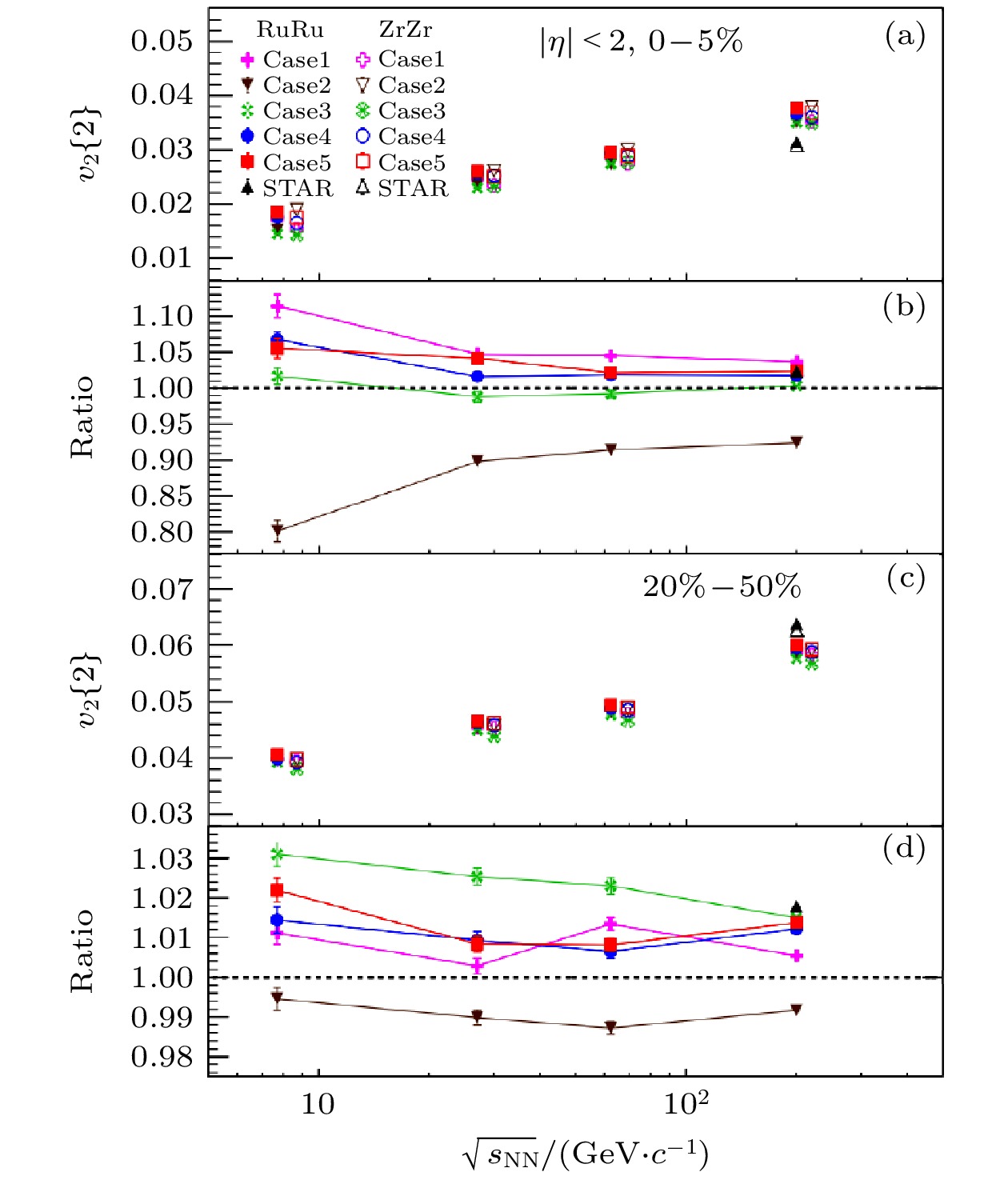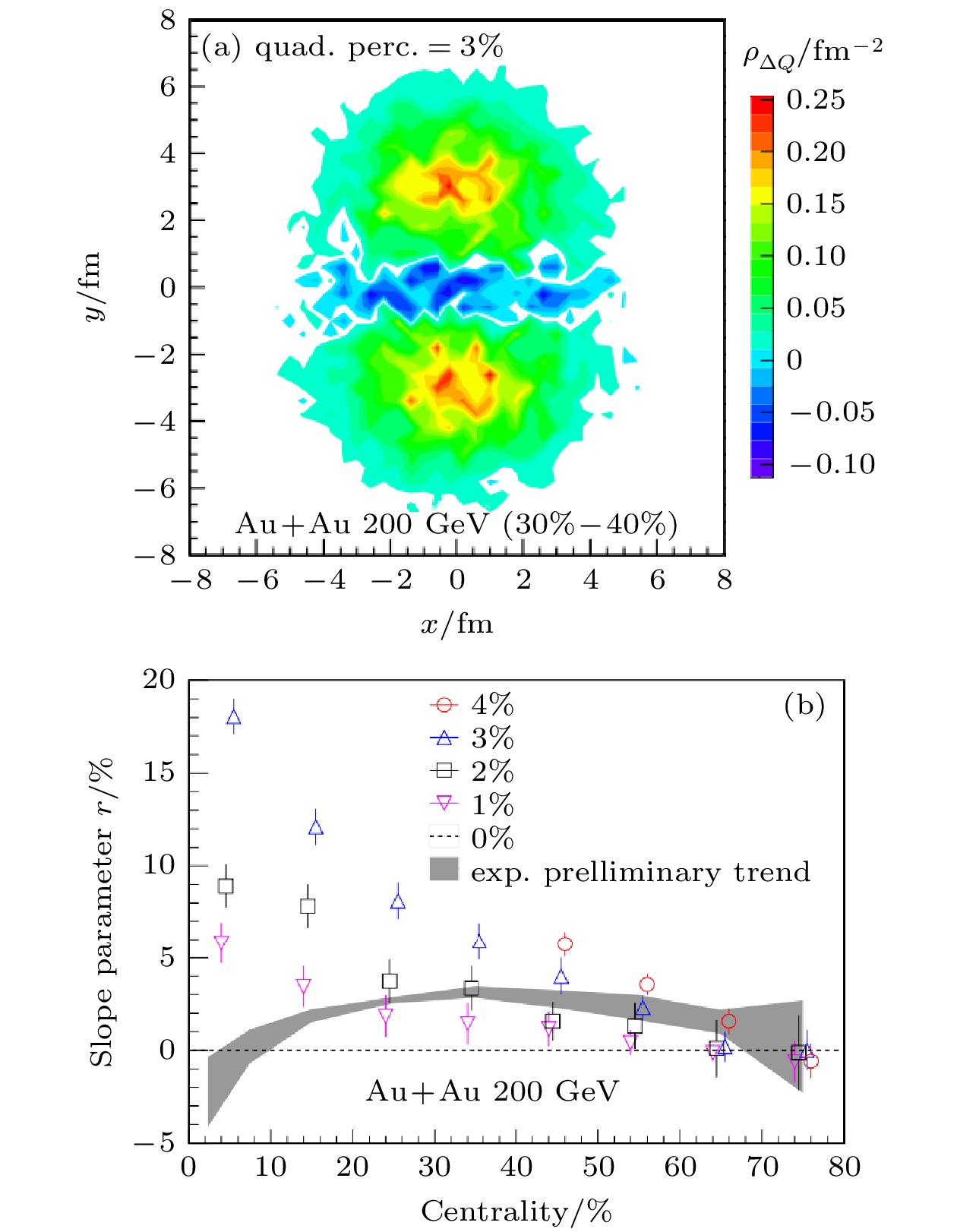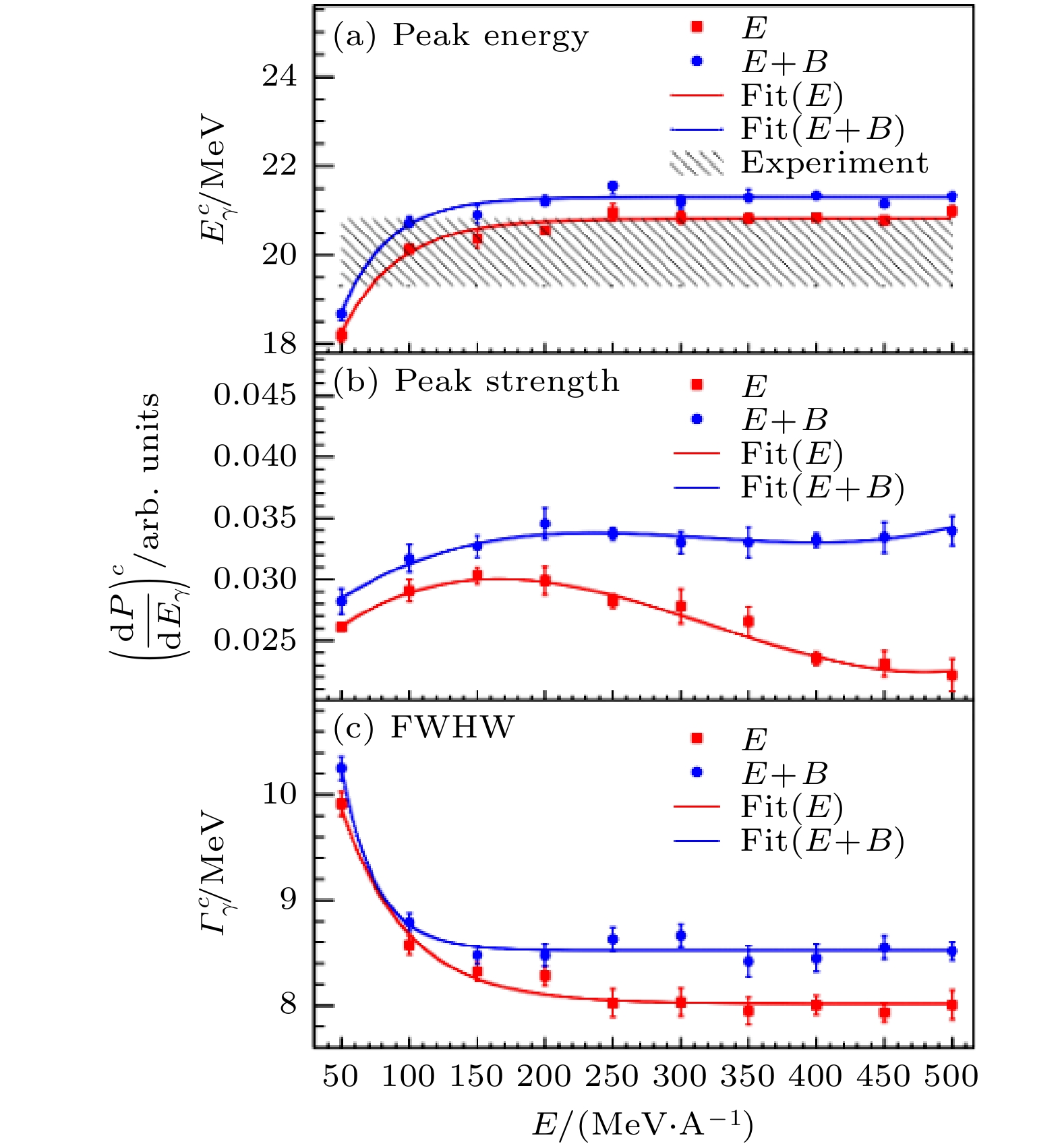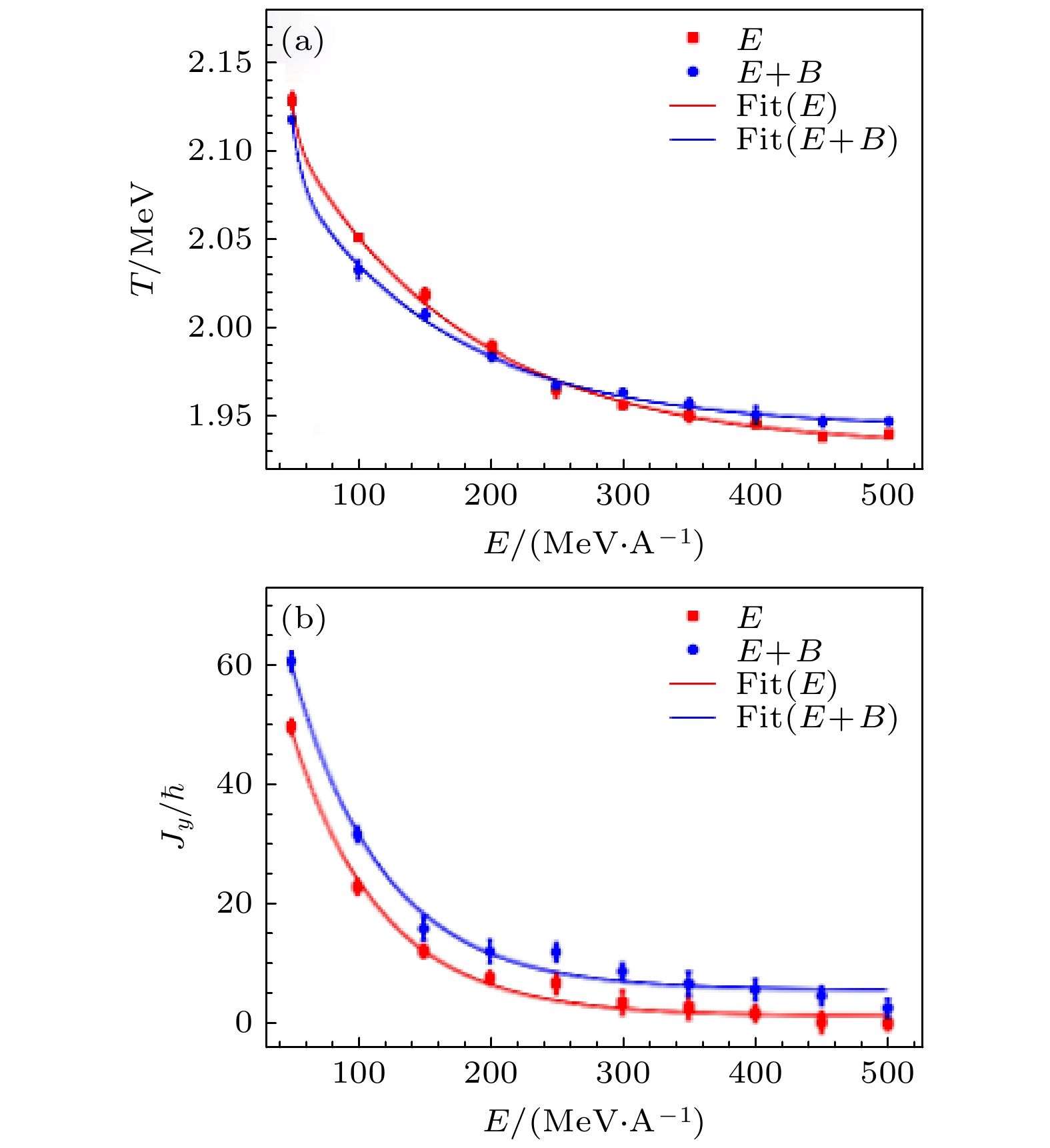-
Heavy-ion collisions can produce high-temperature and high-density quantum chromodynamics (QCD) matter under extremely strong electromagnetic fields, which triggers off many important anomalous chiral phenomena, such as the chiral magnetic effect and chiral magnetic wave. The anomalous chiral phenomena can help to find the evidence of $\cal{CP}$ symmetry breaking in the strong interaction, deepen the understanding of the QCD vacuum fluctuations, and disclose the mystery of asymmetry of antimatter-matter in the universe.In this paper, firstly, the magnetic fields are investigated for small and large colliding systems at relativistic heavy ion collider (RHIC) and large hadron collider (LHC). These studies indicate that collision energy and initial nucleon structure have significant effects on magnetic fields. And, the lifetimes of magnetic field in different media are very different in heavy-ion collisions. Then, in order to study the chiral magnetic effect, some experimental observables are studied by using a multi-phase transport model without or with different strengths of the chiral magnetic effect. For small systems, if QGP exists, the chiral magnetic effect could be observed in the peripheral collisions. For isobaric collisions, the correlators with respect to the spectator plane can imply a much cleaner signal of chiral magnetic effect than that with respect to the participant plane. Our results support that the strength of chiral magnetic effect may be absent or small in isobaric collisions. Next, some new strategies are applied to study the chiral magnetic wave. Moreover, a novel mechanism for the electric quadrupole moment can also explain the charge-dependent elliptic flow of pions generated by the chiral magnetic wave. In addition, some interesting phenomena also occur, owing to the magnetic field in heavy-ion collisions at intermediate energy. The directed flow and elliptic flow of photons have no effect on magnetic field at $p_{\rm T}<25$ GeV. However, because of the magnetic field, the directed flow of photons decreases and the elliptic flow of photons increases at$p_{\rm T}>25$ GeV. Besides, the magnetic field has a significant effect on giant dipole resonance, i.e. the magnetic field increases the angular momentum and enhances some observables of the giant dipole resonance spectrum. In conclusion, magnetic field plays a key role in heavy-ion collisions at both high energy and intermediate energy. It provides an unprecedented opportunity for studying the microscopic laws of nuclear physics. However, there are still many unsolved problems that need further studying in the future.-
Keywords:
- magnetic field /
- deformed nuclei /
- chiral magnetic effect /
- chiral magnetic wave
[1] Gross D J, Wilczek F 1973 Phys. Rev. Lett. 30 1343
 Google Scholar
Google Scholar
[2] Politzer H D 1973 Phys. Rev. Lett. 30 1346
 Google Scholar
Google Scholar
[3] Adams J,Aggarwal M M, Ahammed Z, et al. (STAR Collaboration). 2005 Nucl. Phys. A 757 102
 Google Scholar
Google Scholar
[4] Adcox K, Adler S S, Afanasiev S, et al. (PHENIX Collaboration). 2005 Nucl. Phys. A 757 184
 Google Scholar
Google Scholar
[5] Aamodt K, Quintana A A, Achenbach R, et al. (ALICE Collaboration). 2008 JINST 3 S08002
 Google Scholar
Google Scholar
[6] Bzdak A, Esumi S, Koch V, Liao J, Stephanov M, Xu N 2020 Phys. Rep. 853 1
 Google Scholar
Google Scholar
[7] Luo X, Xu N 2017 Nucl. Sci. Tech. 28 112
 Google Scholar
Google Scholar
[8] Xu J, Liao J, Gyulassy M 2015 Chin. Phys. Lett. 32 092501
 Google Scholar
Google Scholar
[9] Siemens P J, Rasmussen J O 1979 Phys. Rev. Lett. 42 880
 Google Scholar
Google Scholar
[10] Kolb P F, Sollfrank J, Heinz U W 2000 Phys. Rev. C 62 054909
 Google Scholar
Google Scholar
[11] Teaney D, Lauret J, Shuryak E V 2001 Phys. Rev. Lett. 86 4783
 Google Scholar
Google Scholar
[12] Song H, Heinz U W 2008 Phys. Rev. C 77 064901
 Google Scholar
Google Scholar
[13] Jeon S, Heinz U 2015 Int. J. Mod. Phys. E 24 1530010
 Google Scholar
Google Scholar
[14] Shen C, Yan L 2020 Nucl. Sci. Tech. 31 122
 Google Scholar
Google Scholar
[15] Lao H L, Liu F H, Li B C, Duan M Y, Lacey R A 2018 Nucl. Sci. Tech. 29 164
 Google Scholar
Google Scholar
[16] Waqas M, Liu F H, Li L L, Alfanda H M 2020 Nucl. Sci. Tech. 31 109
 Google Scholar
Google Scholar
[17] Poskanzer A M, Voloshin S A 1998 Phys. Rev. C 58 1671
 Google Scholar
Google Scholar
[18] Gale C, Jeon S, Schenke B 2013 Int. J. Mod. Phys. A 28 1340011
 Google Scholar
Google Scholar
[19] Alver B, Roland G 2010 Phys. Rev. C 81 054905
 Google Scholar
Google Scholar
[20] Ma G L, Wang X N 2011 Phys. Rev. Lett. 106 162301
 Google Scholar
Google Scholar
[21] Ma L, Ma G L, Ma Y G 2016 Phys. Rev. C 94 044915
 Google Scholar
Google Scholar
[22] Lee T D, Yang C N 1956 Phys. Rev. 104 254
 Google Scholar
Google Scholar
[23] Christenson J H, Cronin J W, Fitch V L, Turlay R 1964 Phys. Rev. Lett. 13 138
 Google Scholar
Google Scholar
[24] Skokov V, Illarionov A Y, Toneev V 2009 Int. J. Mod. Phys. A 24 5925
 Google Scholar
Google Scholar
[25] Bzdak A, Skokov V 2012 Phys. Lett. B 710 171
 Google Scholar
Google Scholar
[26] Deng W T, Huang X G 2012 Phys. Rev. C 85 044907
 Google Scholar
Google Scholar
[27] Hattori K, Huang X G 2017 Nucl. Sci. Tech. 28 26
 Google Scholar
Google Scholar
[28] Rojas H P, Martinez A P, Cuesta H J M 2004 Chin. Phys. Lett. 21 2117
 Google Scholar
Google Scholar
[29] Kharzeev D 2006 Phys. Lett. B 633 260
 Google Scholar
Google Scholar
[30] Kharzeev D, Zhitnitsky A 2007 Nucl. Phys. A 797 67
 Google Scholar
Google Scholar
[31] Kharzeev D E, McLerran L D, Warringa H J 2008 Nucl. Phys. A 803 227
 Google Scholar
Google Scholar
[32] Fukushima F, Kharzeev D E, Warringa H J 2008 Phys. Rev. D 78 074033
 Google Scholar
Google Scholar
[33] Son D T, Zhitnitsky A R 2004 Phys. Rev. D 70 074018
 Google Scholar
Google Scholar
[34] Metlitski M A, Zhitnitsky A R 2005 Phys. Rev. D 72 045011
 Google Scholar
Google Scholar
[35] Kharzeev D E, Liao J F, Voloshin S A, Wang G 2016 Prog. Part. Nucl. Phys. 88 1
 Google Scholar
Google Scholar
[36] Kharzeev D E, Yee H U 2011 Phys. Rev. D 83 085007
 Google Scholar
Google Scholar
[37] 罗晓丽, 高建华 2023 物理学报 72 112503
 Google Scholar
Google Scholar
Luo X L, Gao J H 2023 Acta Phys. Sin. 72 112503
 Google Scholar
Google Scholar
[38] Bertsch G F, Gupta S D 1988 Phys. Rep. 160 189
 Google Scholar
Google Scholar
[39] Maruyama T, Niita K, Iwamoto A 1996 Phys. Rev. C 53 297
 Google Scholar
Google Scholar
[40] Lin Z W, Ko C M, Li B A, Zhang B, Pal S 2005 Phys. Rev. C 72 064901
 Google Scholar
Google Scholar
[41] Zhao X L, Ma Y G, Ma G L 2018 Phys. Rev. C 97 024910
 Google Scholar
Google Scholar
[42] Zhao X L, Ma G L, Ma Y G 2019 Phys. Rev. C 99 034903
 Google Scholar
Google Scholar
[43] Deng W T, Huang X G, Ma G L, Wang G 2018 Phys. Rev. C 97 044901
 Google Scholar
Google Scholar
[44] Cheng Y L, Zhang S, Ma Y G, Chen J H, Zhong C 2019 Phys. Rev. C 99 054906
 Google Scholar
Google Scholar
[45] Chen Y, Sheng X L, Ma G L 2021 Nucl. Phys. A 1011 122199
 Google Scholar
Google Scholar
[46] Zhong Y, Yang C B, Cai X, Feng S Q 2015 Chin. Phys. C 39 104105
 Google Scholar
Google Scholar
[47] Kharzeev D E, Liao J F 2021 Nat. Rev. Phys. 3 55
 Google Scholar
Google Scholar
[48] Huang X G 2016 Rept. Prog. Phys. 79 076302
 Google Scholar
Google Scholar
[49] Gao J H, Ma G L, Pu S, Wang Q 2020 Nucl. Sci. Tech. 31 90
 Google Scholar
Google Scholar
[50] Voloshin S A 2004 Phys. Rev. C 70 057901
 Google Scholar
Google Scholar
[51] Abelev B I, Aggarwal M M, Ahammed Z, et al. [STAR]. 2009 Phys. Rev. Lett. 103 251601
 Google Scholar
Google Scholar
[52] Abelev B I, Aggarwal M M, Ahammed Z, et al. 2010 Phys. Rev. C 81 054908
 Google Scholar
Google Scholar
[53] Adamczyk L, Adkins J K, Agakishiev G, et al. [STAR]. 2013 Phys. Rev. C 88 064911
 Google Scholar
Google Scholar
[54] Adamczyk L, Adkins J K, Agakishiev G, et al. [STAR]. 2014 Phys. Rev. Lett. 113 052302
 Google Scholar
Google Scholar
[55] Abelev B, Adam J, Adamova D, et al. [ALICE]. 2013 Phys. Rev. Lett. 110 012301
 Google Scholar
Google Scholar
[56] Lin Z W, Zheng L 2021 Nucl. Sci. Tech. 32 113
 Google Scholar
Google Scholar
[57] Ma G L, Zhang B 2011 Phys. Lett. B 700 39
 Google Scholar
Google Scholar
[58] Shou Q Y, Ma G L, Ma Y G 2014 Phys. Rev. C 90 047901
 Google Scholar
Google Scholar
[59] Huang L, Ma C W, Ma G L 2018 Phys. Rev. C 97 034909
 Google Scholar
Google Scholar
[60] Huang L, Nie M W, Ma G L 2020 Phys. Rev. C 101 024916
 Google Scholar
Google Scholar
[61] Khachatryan V, Sirunyan A M, Tumasyan A, et al. [CMS]. 2017 Phys. Rev. Lett. 118 122301
 Google Scholar
Google Scholar
[62] Zhang Z W, Cen X Z, Deng W T 2022 Chin. Phys. C 46 084103
 Google Scholar
Google Scholar
[63] Bzdak A, Koch V, Liao J 2011 Phys. Rev. C 83 014905
 Google Scholar
Google Scholar
[64] Liao J, Koch V, Bzdak A 2010 Phys. Rev. C 82 054902
 Google Scholar
Google Scholar
[65] Schlichting S, Pratt S 2011 Phys. Rev. C 83 014913
 Google Scholar
Google Scholar
[66] Wang F 2010 Phys. Rev. C 81 064902
 Google Scholar
Google Scholar
[67] Zhao J [STAR] 2021 Nucl. Phys. A 1005 121766
 Google Scholar
Google Scholar
[68] Zhao J, Wang F 2019 Prog. Part. Nucl. Phys. 107 200
 Google Scholar
Google Scholar
[69] Wang F 2022 Acta Phys. Polon. Supp. 16 15
[70] Li W, Wang G 2020 Ann. Rev. Nucl. Part. Sci. 70 293
 Google Scholar
Google Scholar
[71] Voloshin S A 2010 Phys. Rev. Lett. 105 172301
 Google Scholar
Google Scholar
[72] Deng W T, Huang X G, Ma G L, Wang G 2016 Phys. Rev. C 94 041901
 Google Scholar
Google Scholar
[73] Adam J, Adamczyk L, Adams J R, et al. [STAR]. 2021 Nucl. Sci. Tech. 32 48
 Google Scholar
Google Scholar
[74] Abdallah M, Aboona B E, Adam J, et al. [STAR]. 2022 Phys. Rev. C 105 014901
 Google Scholar
Google Scholar
[75] Xu H J, Li H, Wang X, Shen C, Wang F 2021 Phys. Lett. B 819 136453
 Google Scholar
Google Scholar
[76] Xu H J, Zhao W, Li H, Zhou Y, Chen L W, Wang F 2021 arXiv: 2111.14812 [nucl-th]
[77] Zhang C, Jia J 2022 Phys. Rev. Lett. 128 022301
 Google Scholar
Google Scholar
[78] Jia J, Zhang C J 2023 Phys. Rev. C 107 L021901
 Google Scholar
Google Scholar
[79] Jia J 2022 Phys. Rev. C 105 014905
 Google Scholar
Google Scholar
[80] Jia J 2022 Phys. Rev. C 105 044905
 Google Scholar
Google Scholar
[81] Zhao X L, Ma G L 2022 Phys. Rev. C 106 034909
 Google Scholar
Google Scholar
[82] Kharzeev D E, Liao J, Shi S 2022 Phys. Rev. C 106 L051903
 Google Scholar
Google Scholar
[83] Li F, Ma Y G, Zhang S, Ma G L, Shou Q, Shou Q Y 2022 Phys. Rev. C 106 014906
 Google Scholar
Google Scholar
[84] Wang F Q, Zhao J 2018 Nucl. Sci. Tech. 29 179
 Google Scholar
Google Scholar
[85] Xu H J, Zhao J, Wang X, Li H, Lin Z W, Shen C, Wang F 2018 Chin. Phys. C 42 084103
 Google Scholar
Google Scholar
[86] Choudhury S, Dong X, Drachenberg J, et al. 2022 Chin. Phys. C 46 014101
 Google Scholar
Google Scholar
[87] Tang A H 2020 Chin. Phys. C 44 054101
 Google Scholar
Google Scholar
[88] Liang G R, Liao H F, Lin S, Yan Li, Li M 2020 Chin. Phys. C 44 094103
 Google Scholar
Google Scholar
[89] Chen B X, Feng S Q 2020 Chin. Phys. C 44 024104
 Google Scholar
Google Scholar
[90] Feng S Q, Pei L, Sun F, Zhong Y, Yin Z B 2018 Chin. Phys. C 42 054102
 Google Scholar
Google Scholar
[91] Jiang Y, Shi S, Yin Y, Liao J 2018 Chin. Phys. C 42 011001
 Google Scholar
Google Scholar
[92] Yee H U, Yin Y 2014 Phys. Rev. C 89 044909
 Google Scholar
Google Scholar
[93] Taghavi S F, Wiedemann U A 2015 Phys. Rev. C 91 024902
 Google Scholar
Google Scholar
[94] Hongo M, Hirono Y, Hirano T 2017 Phys. Lett. B 775 266
 Google Scholar
Google Scholar
[95] Adamczyk L, Adkins J K, Agakishiev G, et al. [STAR]. 2015 Phys. Rev. Lett. 114 252302
 Google Scholar
Google Scholar
[96] Adam J, Adamova D, Aggarwal M M, et al. [ALICE]. 2016 Phys. Rev. C 93 044903
 Google Scholar
Google Scholar
[97] Ma G L 2014 Phys. Lett. B 735 383
 Google Scholar
Google Scholar
[98] Zhao X L, Ma G L, Ma Y G 2019 Phys. Lett. B 792 413
 Google Scholar
Google Scholar
[99] Wang C Z, Wu W Y, Shou Q Y, Ma G L, Ma Y G, Zhang S 2021 Phys. Lett. B 820 136580
 Google Scholar
Google Scholar
[100] Wu W Y, Shou Q Y, Christakoglou P, Das P, Haque M R, Ma G L, Ma Y G, Mohanty B, Wang C Z, Zhang S, Zhao J 2023 Phys. Rev. C 107 L031902
 Google Scholar
Google Scholar
[101] Shen D Y, Chen J H, Ma G L, Ma Y G, Shou Q Y, Zhang S, Zhong C 2019 Phys. Rev. C 100 064907
 Google Scholar
Google Scholar
[102] Deng X G, Ma Y G 2018 Eur. Phys. J. A 54 204
 Google Scholar
Google Scholar
[103] Cao Y T, Deng X G, Ma Y G 2022 Phys. Rev. C 106 014611
 Google Scholar
Google Scholar
[104] 阮丽娟, 许长补, 杨驰 2023 物理学报 72 112401
 Google Scholar
Google Scholar
Ruan L J, Xu Z B, Yang C 2023 Acta Phys. Sin. 72 112401
 Google Scholar
Google Scholar
[105] 寿齐烨, 赵杰, 徐浩洁, 李威, 王钢, 唐爱洪, 王福强 2023 物理学报 72 112504
 Google Scholar
Google Scholar
Shou Q Y, Zhao J, Xu H J, Li W, Wang G, Tang A H, Wang F Q 2023 Acta Phys. Sin. 72 112504
 Google Scholar
Google Scholar
[106] 高建华, 盛欣力, 王群, 庄鹏飞 2023 物理学报 72 112501
 Google Scholar
Google Scholar
Gao J H, Sheng X L, Wang Q, Zhuang P F 2023 Acta Phys. Sin. 72 112501
 Google Scholar
Google Scholar
[107] 浦实, 黄旭光 2023 物理学报 72 071202
 Google Scholar
Google Scholar
Pu S, Huang X G 2023 Acta Phys. Sin. 72 071202
 Google Scholar
Google Scholar
-
图 3 RHIC能量下形变old case1情况下(a)
${\rm{Ru}}+{\rm{Ru}}$ 碰撞和(b)$ \rm Zr+Zr $ 碰撞中的电磁场与碰撞参数b的依赖关系; (c)两个同质异位素碰撞中磁场的相对差异与碰撞参数b的依赖关系Figure 3. Dependences of electromagnetic fields on the impact parameter b for (a)
$ \rm Ru+Ru $ collisions and (b)$ \rm Zr+Zr $ collisions at RHIC energy. (c) Dependence of the relative ratio between the magnetic fields in the two isobaric collisions on the impact parameter b图 7 RHIC能量下
$ \rm Au+Au $ 碰撞中, (a)不同初始电荷分离强度下电荷方位角关联与碰撞中心度的依赖关系, (b) 10%的初始电荷分离强度下, AMPT模型不同碰撞阶段的电荷分离百分比与碰撞中心度的依赖关系Figure 7. (a) Centrality dependence of
$ \rm cos(\phi_{\alpha}+\phi_{\beta}) $ with the different fractions of charge separation in$ \rm Au+Au $ collisions at 200 GeV; (b) centrality dependence of charge separation percentage for different evolution stages in$ \rm Au+Au $ collisions at the RHIC energy, for 10% initial charge separation图 8 在RHIC能量下
$ \rm Au+Au $ 碰撞中部分子相末态中CME粒子的分布, 其中(a)$ \sigma = 0 $ mb; (b)$ \sigma = 10 $ mb. (c) 10%的初始局域电荷分离强度下关联$ \rm cos(\phi_{\alpha}+\phi_{\beta}) $ 对碰撞中心度的依赖性Figure 8. Transverse spatial distribution of CME particles in the final partonic state in
$ \rm Au+Au $ collisions at the RHIC energy, (a) for 0 mb and (b) for 10 mb. (c) Centrality dependence of the azimuthal correlation$ \rm cos(\phi_{\alpha}+\phi_{\beta}) $ with 10% of the initial local charge separation图 9 LHC能量下
$ \rm Pb+Pb $ 碰撞中, (a)电荷方位角关联γ与碰撞中心度的依赖关系, 以及(b)30%—50%中心度下, 电荷方位角关联γ与横动量$ p_{\rm T} $ 的依赖关系Figure 9. (a) Centrality dependence of the charge azimuthal correlation γ in
$ \rm Pb+Pb $ collisions at LHC energy; (b) transverse momentum$ p_{\rm T} $ dependence of the charge azimuthal correlation γ for 30%–50% centrality bin in$ \rm Pb+Pb $ collisions at the LHC energy图 11 (a) CMS合作组测量的在LHC能量下
${\rm{p}}\rm+Pb$ 和$ \rm Pb+Pb $ 碰撞中三粒子方位角关联对$ N_{\rm track} $ 的依赖性[61]; (b)不同能量和小系统碰撞下磁场方位角关联对$ N_{\rm track} $ 的依赖性Figure 11. (a)
$ N_{\rm track} $ dependences of the three-particle azimuthal correlations in${\rm{p}}\rm+Pb$ and$ \rm Pb+Pb $ collisions at the LHC energy measured by the CMS Collaboration; (b)$ N_{\rm track} $ dependences of correlation between the magnetic field and the event plane for small collisions at different energies图 12 RHIC能量的同质异位素碰撞中, (a) old case1的同质异位素碰撞中粒子分布比; (b)
$ S=N_{\rm part}\times\Delta\gamma $ 与中心度的依赖关系; (c) S的相对比值与中心度的依赖关系Figure 12. (a) Ratio of multiplicity distribution between two isobar collisions for the deformation old case1; (b) centrality dependence of
$ S=N_{\rm part}\times\Delta\gamma $ ; (c) centrality dependence of the relative ratio of S图 13 RHIC能量的同质异位素碰撞中, (a)方位角关联及其相对比值与中心度的依赖关系; (b)
$ H=\gamma^{\rm CME}-\gamma^{\rm no\; CME} $ 及其相对比值与中心度的依赖关系; (c)初始电荷分离强度和末态电荷分离强度及其相对比值对碰撞参数b的依赖关系Figure 13. In isobar collisions at the RHIC energy: (a) The centrality dependence of azimuthal correlation and its relative ratio; (b) the centrality dependence of
$ H=\gamma^{\rm CME}-\gamma^{\rm no\; CME} $ and its relative ratio; (c) the impact parameter b dependence of initial charge separation strength and final state charge separation strength and its relative ratios图 14 RHIC能量的同质异位素碰撞中, (a)与
$ \varPsi_{2}^{\rm PP} $ 有关的关联的相对比值与中心度的依赖关系; (b)与$ \varPsi_{2}^{\rm SP} $ 有关的关联的相对比值与中心度的依赖关系Figure 14. In isobar collisions at the RHIC energy, (a) centrality dependence of the relative ratios of the correlations related to
$ \varPsi_{2}^{\rm PP} $ ; (b) centrality dependence of the relative ratios of the correlations related to$ \varPsi_{2}^{\rm SP} $ 图 15 RHIC能量的同质异位素碰撞中不同电荷分离强度下, (a)带电粒子分布比值, (b)平均带电粒子比值与中心度的依赖关系以及(c)
$ v_2 $ 比值与中心度的依赖关系与实验结果的对比Figure 15. (a) The charged particle multiplicity distribution ratio, (b) the centrality dependence of average charged particle ratio, and (c) the centrality dependence of
$ v_2 $ ratio in isotopic collisions for different charge separation strengths at the RHIC energy, in comparison with the STAR data图 17 RHIC能量的同质异位素碰撞中, 0—5%中心度中(a)
$v_2\{2\}$ 及(b)其比值和20%—50%中心度中(c)$ v_{2}\{2\} $ 及(d)其比值与碰撞能量$ \sqrt{s} $ 的依赖关系Figure 17. Collision energy
$ \sqrt{s} $ dependence of (a)$ v_{2}\{2\} $ and (b) its ratio in 0–5% centrality bin, and collision energy$ \sqrt {s} $ dependence of (c)$v_2\{2\}$ and (d) its ratio in 20%–50% centrality bin (lower panel) in isobar collisions at the RHIC energy图 19 RHIC能量30%—40%中心度
$ \rm Au+Au $ 碰撞中, (a)初态部分子态的3%初始四极矩强度在横平面的净电荷密度分布; (b)不同初态部分子四极矩强度下斜率参数对中心度的依赖性Figure 19. (a) Net charge density distribution in the transverse plane for the 3% initial quadrupole charge separation for 30%–40% centrality bin in
$ \rm Au + Au $ collisions at the RHIC energy; (b) centrality dependence of the slope parameter for different strengths of initial quadrupole charge separation图 20 (a) RHIC能量碰撞参数
$ b = 10 $ fm下$ \rm Au+Au $ 碰撞中$e^2\langle {\boldsymbol{E}} \cdot {\boldsymbol{B}}\rangle$ 在横平面上的分布; (b)不同计算方法得出的$ \langle {\boldsymbol{E}}\cdot{\boldsymbol{ B}}\rangle $ 在$ t = 0 $ 时在$ y < 0 $ fm的横向平面内的分区平均密度和斜率参数的碰撞中心度依赖性Figure 20. (a) Spatial distributions of
$ e^2\langle {\boldsymbol{E}} \cdot {\boldsymbol{B}}\rangle $ in the transverse plane at$ t = 0 $ for$ b = 10 $ fm in$ \rm Au+Au $ collisions at the RHIC energy, where the unit is$ m_\pi^4 $ ; (b) zone-averaged density of$ \langle {\boldsymbol{E}} \cdot {\boldsymbol{B}}\rangle $ from different calculation methods (open symbols) at$ t = 0 $ in the transverse plane of$ y < 0 $ fm and the slope parameter (red filled symbol) as functions of$ N_{{\rm{part}}} $ in$ \rm Au+Au $ collisions at the RHIC energy图 21 (a)
$ A_{\rm ch}-\Delta v_2 $ 的斜率与$ \left < v_2 \right > $ 的依赖关系; (b)积分的三粒子关联的差与$ \left < v_2 \right > $ 的依赖关系Figure 21. (a)
$ \left < v_2 \right > $ dependence of the slope of$ A_{\rm ch}-\Delta v_2 $ ; (b)$ \left < v_2 \right > $ dependence of the difference of the integrated three-particle correlator -
[1] Gross D J, Wilczek F 1973 Phys. Rev. Lett. 30 1343
 Google Scholar
Google Scholar
[2] Politzer H D 1973 Phys. Rev. Lett. 30 1346
 Google Scholar
Google Scholar
[3] Adams J,Aggarwal M M, Ahammed Z, et al. (STAR Collaboration). 2005 Nucl. Phys. A 757 102
 Google Scholar
Google Scholar
[4] Adcox K, Adler S S, Afanasiev S, et al. (PHENIX Collaboration). 2005 Nucl. Phys. A 757 184
 Google Scholar
Google Scholar
[5] Aamodt K, Quintana A A, Achenbach R, et al. (ALICE Collaboration). 2008 JINST 3 S08002
 Google Scholar
Google Scholar
[6] Bzdak A, Esumi S, Koch V, Liao J, Stephanov M, Xu N 2020 Phys. Rep. 853 1
 Google Scholar
Google Scholar
[7] Luo X, Xu N 2017 Nucl. Sci. Tech. 28 112
 Google Scholar
Google Scholar
[8] Xu J, Liao J, Gyulassy M 2015 Chin. Phys. Lett. 32 092501
 Google Scholar
Google Scholar
[9] Siemens P J, Rasmussen J O 1979 Phys. Rev. Lett. 42 880
 Google Scholar
Google Scholar
[10] Kolb P F, Sollfrank J, Heinz U W 2000 Phys. Rev. C 62 054909
 Google Scholar
Google Scholar
[11] Teaney D, Lauret J, Shuryak E V 2001 Phys. Rev. Lett. 86 4783
 Google Scholar
Google Scholar
[12] Song H, Heinz U W 2008 Phys. Rev. C 77 064901
 Google Scholar
Google Scholar
[13] Jeon S, Heinz U 2015 Int. J. Mod. Phys. E 24 1530010
 Google Scholar
Google Scholar
[14] Shen C, Yan L 2020 Nucl. Sci. Tech. 31 122
 Google Scholar
Google Scholar
[15] Lao H L, Liu F H, Li B C, Duan M Y, Lacey R A 2018 Nucl. Sci. Tech. 29 164
 Google Scholar
Google Scholar
[16] Waqas M, Liu F H, Li L L, Alfanda H M 2020 Nucl. Sci. Tech. 31 109
 Google Scholar
Google Scholar
[17] Poskanzer A M, Voloshin S A 1998 Phys. Rev. C 58 1671
 Google Scholar
Google Scholar
[18] Gale C, Jeon S, Schenke B 2013 Int. J. Mod. Phys. A 28 1340011
 Google Scholar
Google Scholar
[19] Alver B, Roland G 2010 Phys. Rev. C 81 054905
 Google Scholar
Google Scholar
[20] Ma G L, Wang X N 2011 Phys. Rev. Lett. 106 162301
 Google Scholar
Google Scholar
[21] Ma L, Ma G L, Ma Y G 2016 Phys. Rev. C 94 044915
 Google Scholar
Google Scholar
[22] Lee T D, Yang C N 1956 Phys. Rev. 104 254
 Google Scholar
Google Scholar
[23] Christenson J H, Cronin J W, Fitch V L, Turlay R 1964 Phys. Rev. Lett. 13 138
 Google Scholar
Google Scholar
[24] Skokov V, Illarionov A Y, Toneev V 2009 Int. J. Mod. Phys. A 24 5925
 Google Scholar
Google Scholar
[25] Bzdak A, Skokov V 2012 Phys. Lett. B 710 171
 Google Scholar
Google Scholar
[26] Deng W T, Huang X G 2012 Phys. Rev. C 85 044907
 Google Scholar
Google Scholar
[27] Hattori K, Huang X G 2017 Nucl. Sci. Tech. 28 26
 Google Scholar
Google Scholar
[28] Rojas H P, Martinez A P, Cuesta H J M 2004 Chin. Phys. Lett. 21 2117
 Google Scholar
Google Scholar
[29] Kharzeev D 2006 Phys. Lett. B 633 260
 Google Scholar
Google Scholar
[30] Kharzeev D, Zhitnitsky A 2007 Nucl. Phys. A 797 67
 Google Scholar
Google Scholar
[31] Kharzeev D E, McLerran L D, Warringa H J 2008 Nucl. Phys. A 803 227
 Google Scholar
Google Scholar
[32] Fukushima F, Kharzeev D E, Warringa H J 2008 Phys. Rev. D 78 074033
 Google Scholar
Google Scholar
[33] Son D T, Zhitnitsky A R 2004 Phys. Rev. D 70 074018
 Google Scholar
Google Scholar
[34] Metlitski M A, Zhitnitsky A R 2005 Phys. Rev. D 72 045011
 Google Scholar
Google Scholar
[35] Kharzeev D E, Liao J F, Voloshin S A, Wang G 2016 Prog. Part. Nucl. Phys. 88 1
 Google Scholar
Google Scholar
[36] Kharzeev D E, Yee H U 2011 Phys. Rev. D 83 085007
 Google Scholar
Google Scholar
[37] 罗晓丽, 高建华 2023 物理学报 72 112503
 Google Scholar
Google Scholar
Luo X L, Gao J H 2023 Acta Phys. Sin. 72 112503
 Google Scholar
Google Scholar
[38] Bertsch G F, Gupta S D 1988 Phys. Rep. 160 189
 Google Scholar
Google Scholar
[39] Maruyama T, Niita K, Iwamoto A 1996 Phys. Rev. C 53 297
 Google Scholar
Google Scholar
[40] Lin Z W, Ko C M, Li B A, Zhang B, Pal S 2005 Phys. Rev. C 72 064901
 Google Scholar
Google Scholar
[41] Zhao X L, Ma Y G, Ma G L 2018 Phys. Rev. C 97 024910
 Google Scholar
Google Scholar
[42] Zhao X L, Ma G L, Ma Y G 2019 Phys. Rev. C 99 034903
 Google Scholar
Google Scholar
[43] Deng W T, Huang X G, Ma G L, Wang G 2018 Phys. Rev. C 97 044901
 Google Scholar
Google Scholar
[44] Cheng Y L, Zhang S, Ma Y G, Chen J H, Zhong C 2019 Phys. Rev. C 99 054906
 Google Scholar
Google Scholar
[45] Chen Y, Sheng X L, Ma G L 2021 Nucl. Phys. A 1011 122199
 Google Scholar
Google Scholar
[46] Zhong Y, Yang C B, Cai X, Feng S Q 2015 Chin. Phys. C 39 104105
 Google Scholar
Google Scholar
[47] Kharzeev D E, Liao J F 2021 Nat. Rev. Phys. 3 55
 Google Scholar
Google Scholar
[48] Huang X G 2016 Rept. Prog. Phys. 79 076302
 Google Scholar
Google Scholar
[49] Gao J H, Ma G L, Pu S, Wang Q 2020 Nucl. Sci. Tech. 31 90
 Google Scholar
Google Scholar
[50] Voloshin S A 2004 Phys. Rev. C 70 057901
 Google Scholar
Google Scholar
[51] Abelev B I, Aggarwal M M, Ahammed Z, et al. [STAR]. 2009 Phys. Rev. Lett. 103 251601
 Google Scholar
Google Scholar
[52] Abelev B I, Aggarwal M M, Ahammed Z, et al. 2010 Phys. Rev. C 81 054908
 Google Scholar
Google Scholar
[53] Adamczyk L, Adkins J K, Agakishiev G, et al. [STAR]. 2013 Phys. Rev. C 88 064911
 Google Scholar
Google Scholar
[54] Adamczyk L, Adkins J K, Agakishiev G, et al. [STAR]. 2014 Phys. Rev. Lett. 113 052302
 Google Scholar
Google Scholar
[55] Abelev B, Adam J, Adamova D, et al. [ALICE]. 2013 Phys. Rev. Lett. 110 012301
 Google Scholar
Google Scholar
[56] Lin Z W, Zheng L 2021 Nucl. Sci. Tech. 32 113
 Google Scholar
Google Scholar
[57] Ma G L, Zhang B 2011 Phys. Lett. B 700 39
 Google Scholar
Google Scholar
[58] Shou Q Y, Ma G L, Ma Y G 2014 Phys. Rev. C 90 047901
 Google Scholar
Google Scholar
[59] Huang L, Ma C W, Ma G L 2018 Phys. Rev. C 97 034909
 Google Scholar
Google Scholar
[60] Huang L, Nie M W, Ma G L 2020 Phys. Rev. C 101 024916
 Google Scholar
Google Scholar
[61] Khachatryan V, Sirunyan A M, Tumasyan A, et al. [CMS]. 2017 Phys. Rev. Lett. 118 122301
 Google Scholar
Google Scholar
[62] Zhang Z W, Cen X Z, Deng W T 2022 Chin. Phys. C 46 084103
 Google Scholar
Google Scholar
[63] Bzdak A, Koch V, Liao J 2011 Phys. Rev. C 83 014905
 Google Scholar
Google Scholar
[64] Liao J, Koch V, Bzdak A 2010 Phys. Rev. C 82 054902
 Google Scholar
Google Scholar
[65] Schlichting S, Pratt S 2011 Phys. Rev. C 83 014913
 Google Scholar
Google Scholar
[66] Wang F 2010 Phys. Rev. C 81 064902
 Google Scholar
Google Scholar
[67] Zhao J [STAR] 2021 Nucl. Phys. A 1005 121766
 Google Scholar
Google Scholar
[68] Zhao J, Wang F 2019 Prog. Part. Nucl. Phys. 107 200
 Google Scholar
Google Scholar
[69] Wang F 2022 Acta Phys. Polon. Supp. 16 15
[70] Li W, Wang G 2020 Ann. Rev. Nucl. Part. Sci. 70 293
 Google Scholar
Google Scholar
[71] Voloshin S A 2010 Phys. Rev. Lett. 105 172301
 Google Scholar
Google Scholar
[72] Deng W T, Huang X G, Ma G L, Wang G 2016 Phys. Rev. C 94 041901
 Google Scholar
Google Scholar
[73] Adam J, Adamczyk L, Adams J R, et al. [STAR]. 2021 Nucl. Sci. Tech. 32 48
 Google Scholar
Google Scholar
[74] Abdallah M, Aboona B E, Adam J, et al. [STAR]. 2022 Phys. Rev. C 105 014901
 Google Scholar
Google Scholar
[75] Xu H J, Li H, Wang X, Shen C, Wang F 2021 Phys. Lett. B 819 136453
 Google Scholar
Google Scholar
[76] Xu H J, Zhao W, Li H, Zhou Y, Chen L W, Wang F 2021 arXiv: 2111.14812 [nucl-th]
[77] Zhang C, Jia J 2022 Phys. Rev. Lett. 128 022301
 Google Scholar
Google Scholar
[78] Jia J, Zhang C J 2023 Phys. Rev. C 107 L021901
 Google Scholar
Google Scholar
[79] Jia J 2022 Phys. Rev. C 105 014905
 Google Scholar
Google Scholar
[80] Jia J 2022 Phys. Rev. C 105 044905
 Google Scholar
Google Scholar
[81] Zhao X L, Ma G L 2022 Phys. Rev. C 106 034909
 Google Scholar
Google Scholar
[82] Kharzeev D E, Liao J, Shi S 2022 Phys. Rev. C 106 L051903
 Google Scholar
Google Scholar
[83] Li F, Ma Y G, Zhang S, Ma G L, Shou Q, Shou Q Y 2022 Phys. Rev. C 106 014906
 Google Scholar
Google Scholar
[84] Wang F Q, Zhao J 2018 Nucl. Sci. Tech. 29 179
 Google Scholar
Google Scholar
[85] Xu H J, Zhao J, Wang X, Li H, Lin Z W, Shen C, Wang F 2018 Chin. Phys. C 42 084103
 Google Scholar
Google Scholar
[86] Choudhury S, Dong X, Drachenberg J, et al. 2022 Chin. Phys. C 46 014101
 Google Scholar
Google Scholar
[87] Tang A H 2020 Chin. Phys. C 44 054101
 Google Scholar
Google Scholar
[88] Liang G R, Liao H F, Lin S, Yan Li, Li M 2020 Chin. Phys. C 44 094103
 Google Scholar
Google Scholar
[89] Chen B X, Feng S Q 2020 Chin. Phys. C 44 024104
 Google Scholar
Google Scholar
[90] Feng S Q, Pei L, Sun F, Zhong Y, Yin Z B 2018 Chin. Phys. C 42 054102
 Google Scholar
Google Scholar
[91] Jiang Y, Shi S, Yin Y, Liao J 2018 Chin. Phys. C 42 011001
 Google Scholar
Google Scholar
[92] Yee H U, Yin Y 2014 Phys. Rev. C 89 044909
 Google Scholar
Google Scholar
[93] Taghavi S F, Wiedemann U A 2015 Phys. Rev. C 91 024902
 Google Scholar
Google Scholar
[94] Hongo M, Hirono Y, Hirano T 2017 Phys. Lett. B 775 266
 Google Scholar
Google Scholar
[95] Adamczyk L, Adkins J K, Agakishiev G, et al. [STAR]. 2015 Phys. Rev. Lett. 114 252302
 Google Scholar
Google Scholar
[96] Adam J, Adamova D, Aggarwal M M, et al. [ALICE]. 2016 Phys. Rev. C 93 044903
 Google Scholar
Google Scholar
[97] Ma G L 2014 Phys. Lett. B 735 383
 Google Scholar
Google Scholar
[98] Zhao X L, Ma G L, Ma Y G 2019 Phys. Lett. B 792 413
 Google Scholar
Google Scholar
[99] Wang C Z, Wu W Y, Shou Q Y, Ma G L, Ma Y G, Zhang S 2021 Phys. Lett. B 820 136580
 Google Scholar
Google Scholar
[100] Wu W Y, Shou Q Y, Christakoglou P, Das P, Haque M R, Ma G L, Ma Y G, Mohanty B, Wang C Z, Zhang S, Zhao J 2023 Phys. Rev. C 107 L031902
 Google Scholar
Google Scholar
[101] Shen D Y, Chen J H, Ma G L, Ma Y G, Shou Q Y, Zhang S, Zhong C 2019 Phys. Rev. C 100 064907
 Google Scholar
Google Scholar
[102] Deng X G, Ma Y G 2018 Eur. Phys. J. A 54 204
 Google Scholar
Google Scholar
[103] Cao Y T, Deng X G, Ma Y G 2022 Phys. Rev. C 106 014611
 Google Scholar
Google Scholar
[104] 阮丽娟, 许长补, 杨驰 2023 物理学报 72 112401
 Google Scholar
Google Scholar
Ruan L J, Xu Z B, Yang C 2023 Acta Phys. Sin. 72 112401
 Google Scholar
Google Scholar
[105] 寿齐烨, 赵杰, 徐浩洁, 李威, 王钢, 唐爱洪, 王福强 2023 物理学报 72 112504
 Google Scholar
Google Scholar
Shou Q Y, Zhao J, Xu H J, Li W, Wang G, Tang A H, Wang F Q 2023 Acta Phys. Sin. 72 112504
 Google Scholar
Google Scholar
[106] 高建华, 盛欣力, 王群, 庄鹏飞 2023 物理学报 72 112501
 Google Scholar
Google Scholar
Gao J H, Sheng X L, Wang Q, Zhuang P F 2023 Acta Phys. Sin. 72 112501
 Google Scholar
Google Scholar
[107] 浦实, 黄旭光 2023 物理学报 72 071202
 Google Scholar
Google Scholar
Pu S, Huang X G 2023 Acta Phys. Sin. 72 071202
 Google Scholar
Google Scholar
Catalog
Metrics
- Abstract views: 2395
- PDF Downloads: 80
- Cited By: 0


















 DownLoad:
DownLoad:










